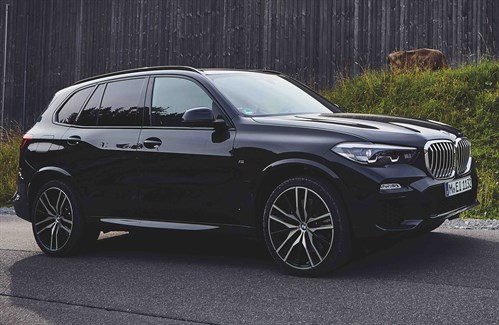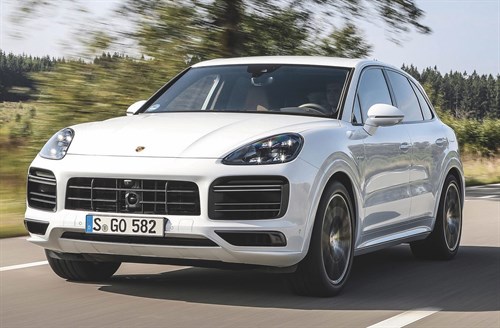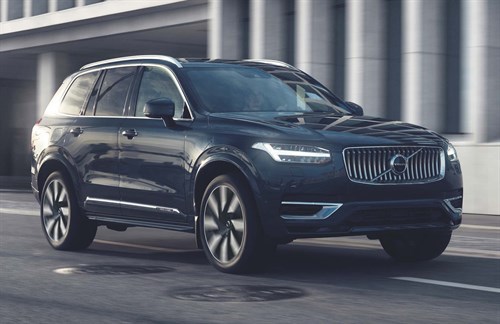We use cookies to ensure that we give you the best experience on our website. If you continue without changing your settings, we will assume that you are happy to receive all cookies on the Business Car website. However, if you would like to, you can change your cookies at any time

The start point for the best source of fleet information |
Best in Class: Plug-in hybrid SUVs
Date: 27 February 2023 | Author: Martyn Collins

Range Rover Sport
Could the all-new, plug-in hybrid version of the Range Rover Sport, launched last year,
be the sweet spot for fleet buyers? After all it is only slightly smaller, yet sportier and more dynamic than its sister car - the all-new Range Rover. Just like the Range Rover, almost everything is new. It shares the same MLA-Flex architecture, it is powered by the same engines, but unlike the rest of the range, the petrol plug-in hybrid P440e that we have here (the more powerful P510e), falls into the 5% BIK band.
The reason for this is the P440e's drivetrain. It combines Land Rover's 3.0-litre straight-six Ingenium petrol with a 105kW electric motor and 38.2kWh battery, hidden under the back seat. This Range Rover starts in full-electric, adding to what is already a refined drive, as it quietly switches to petrol power as speed builds. It might be a plug-in hybrid, but performance for this Range Rover lives up to the 'Sport' name, with acceleration to 60mph taking 5.5 seconds. The P440e can still cover up to 70 miles on electric power alone.
When it comes to charging, the Sport allows 7kW AC home and public charging, plus 50kW rapid DC charging. As such, the battery can be fully recharged from empty to full via 7kW home and public charging in five hours - or just 60 minutes if you choose the rapid DC charging option.
Outside, when compared to the latest Range Rover, the new Sport looks a bit different. This car looks most like its sibling at the front, although the headlights and grille are slimmer. Elsewhere, it has a deep front air dam with the registration plate at the bottom. The rear is where it really differs, with thin, horizontal rear lights and single clamshell boot. Although in our opinion, we still think the Range Rover is better looking.
Inside, the new Sport looks and feels identical to the Range Rover. So, think the same dashboard with its 13.1in tablet-style 'Pivi Pro' navigation system, dominating the centre console and replacing the outgoing two-screen system, with physical ventilation controls. Elsewhere, there's a three-spoke steering wheel - but the same seats with various massaging options.
Now the Sport shares the same 2,997mm wheelbase, there's decent rear legroom. However, the lower roofline gives the Sport's interior a different, more contemporary feel. Boot space is a practical 780 litres - as the battery doesn't affect it.
With soft leather and subtle aluminium trim on the SE model that we drove, there's no doubt the latest Range Rover Sport's interior feels special.
All these models are hybrids, but that's where the similarity ends, as their BIK figures are wildly different. This is down to how many miles they can cover on electric power alone. The Range Rover Sport comes top, being capable of 70 miles and achieves the lowest 5% BiK figure. This is followed by the BMW which is capable of up to 54 miles and the Volvo's 43 miles of EV range - but both have the same 8% BIK figure. Sadly, the Porsche is a long way back with 25 miles and a 19% BIK figure.
Land Rover may quote a 313-353mpg WLTP figure for this Range Rover, but according to figures supplied by Kee Resources, this Sport has a more realistic 28.6mpg figure, which puts it in third place behind the BMW at 31.4mpg (202-235mpg), and the winning Volvo with its 37.5mpg figure (188-235mpg).
Range Rovers have always tended to perform well in terms of residuals, and this is also true of this latest Sport when compared to the opposition according to our figures. The Range Rover comes top with its 60.77% figure, followed by the Porsche at 56.12%, then the BMW at 53.05%, and the oldest model here, the Volvo, in last place at 44.24%. The Range Rover might have the highest residuals, but according to our figures it is not the slowest depreciator here, despite an impressive £33,143 figure. No, the winner is the Porsche, with its £32,290 figure, with the BMW and Volvo third and fourth.
Range Rover Sport 3.0 P440e SE
P11D: £84,475
CO2 (tax): 20g/km (5%)
BIK 20/40% a month: £70/£140
Fuel consumption: 313-353mpg
National Insurance: £1,907
First year VED: £0
Subsequent VED: £155
Engine size/power: 2,997cc/440hp
AFR: 26p
Residual value: 60.77%
Depreciation: £33,143
Fuel costs: £7,822
SMR: £5,382
Cost per mile: 76.37p

BMW X5
On sale for 22 years over four generations, the BMW X5 continues to be popular because it's such a strong fleet choice.
Outside, the fourth-generation X5 might look like an evolution of the previous three, but the tall SUV is attractive and contemporary. The inside is equally tasteful, with high-quality materials and latest tech. The driving position is comfortable, switchgear is logically laid out, and infotainment is easy to use.
Move to the back, there's enough room for three passengers, plus a practically shaped 650-litre boot.
The key fleet choice and the model we're comparing with the Range Rover Sport is the XDrive 45e plug-in hybrid. This combines a 286hp 3.0-litre petrol engine with a 24kWh battery pack and 113hp electric motor. Total power is an impressive 389hp - yet it's still capable of travelling up to 54 miles on electric power alone.
Just behind the Range Rover best sums up the BMW's performance in this group. Tax-wise, at 8% BIK, it comes joint second with the Volvo. At 27g/km, the X5 xDrive45e's emissions are a bit behind the Sport's 20g/km and just ahead of the Volvo at 29g/km. Even with its impressively efficient drivetrain, its 31.4mpg figure is only good enough for second place, behind the Volvo with its 37.5mpg figure. Overall, it's no surprise that the BMW comes a solid second.
BMW X5 xDrive45e 3.0e M Sport
P11D: £74,825
CO2 (tax): 27g/km (8%)
BIK 20/40% a month: £99/£199
Fuel consumption: 202-235mpg
National Insurance: £2,702
First year VED: £0
Subsequent VED: £155
Engine size/power: 2,998cc/389hp
AFR: 26p
Residual value: 53.05%
Depreciation: £34,733
Fuel costs: £8,493
SMR: £4,112
Cost per mile: 78.90p

Porsche Cayenne
Like the X5, the Cayenne is a trailblazing luxury SUV - one of the first from a premium sports manufacturer. Yet 20 years on, no one thinks twice about such a manufacturer offering an SUV.
The third generation is probably the best of its type, too. The E-Hybrid here might be a plug-in hybrid, but no one appears to have told Porsche, as this Cayenne is faster than the standard S. This is because the E-Hybrid adds an electric motor to the 3.0-litre V6 petrol engine, equalling 335hp. Yet, it can still travel 27 miles on electric power alone and can be charged to full in two hours via 7.4kW wallbox.
This Porsche's handling is at the top of its game too, as you'd expect. Although, the E-Hybrid is noticeably less nimble than the rest of the range, thanks to the extra weight of the hybrid kit.
Perhaps the sporting character of the Cayenne counts against the Porsche here. With the smallest electric range, it has the highest 19% BIK figure and lowest fuel economy at 26.5mpg (83mpg WLTP). However, the Porsche badge does count when it comes to residuals, as the Cayenne finishes in second place on 56.68%. However, this isn't enough to save the Porsche from finishing in last place in this comparison.
Porsche Cayenne 3.0 V6 E-Hybrid S
P11D: £74,532
CO2 (tax): 71g/km (19%)
BIK 20/40% a month: £236/£472
Fuel consumption: 83mpg
National Insurance: £6,393
First year VED: £110
Subsequent VED: £155
Engine size/power: 2,995cc/335hp
AFR: 26p
Residual value: 56.12%
Depreciation: £32,290
Fuel costs: £13,248
SMR: £4,922
Cost per mile: 84.10p

Volvo XC90
The XC90 is the oldest model here, having originally been launched with ICE power in 2015.
Although the basic design is eight years old, the T8 was revised as recently as last year. Changes included a bigger battery equalling more power and a longer range.
The most expensive model in the range, the T8 Recharge is powered by a 2.0-litre petrol combined with an 18.8kWh battery and 143hp electric motor equalling 455hp. Its 0-60mph is despatched in an impressive 5.1 seconds, yet it's still capable of covering 43 miles on electric power alone and has a WLTP figure of up to 235mpg.
Considering the performance, it is an easy and tidy drive. The steering is reasonably accurate, and considering the tall stance, the handling is safe and predictable. It rides well despite the large alloys and extra weight of the battery, thanks to the air suspension.
Core trim isn't at the top of the range, but it still includes 19in alloys and LED headlights and all the expected Volvo safety kit.
As this Volvo is capable of 43 miles on electric power, it falls into the same 8% BIK rate as the BMW, which is the joint second lowest figure. Volvo claims a WLTP economy figure of 188-235mpg, while the figures from Kee Resources, suggest it's the most frugal at 37.5mpg. However, the XC60 depreciates the most with its £39,456 figure, preventing it rising higher than third place here.
Volvo XC90 2.0 T8 Core
P11D: £71,350
CO2 (tax): 29g/km (8%)
BIK 20/40% a month: £95/£190
Fuel consumption: 188-235mpg
National Insurance: £2,577
First year VED: £10
Subsequent VED: £155
Engine size/power: 1,969cc/455hp
AFR: 17p
Residual value: 44.24%
Depreciation: £39,787
Fuel costs: £7,849
SMR: £2,847
Cost per mile: 83.59p











